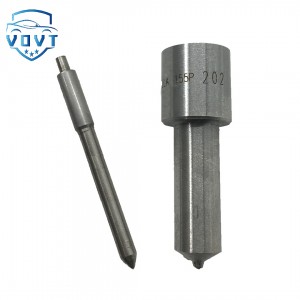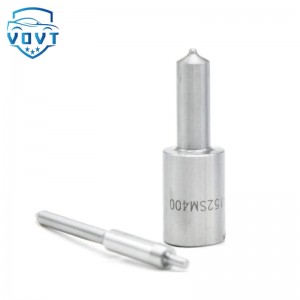New High Quality Diesel Nozzle F00VX30041 for Injection Nozzle Diesel Engine Parts
Products Description
| Reference. Codes | F00VX30041 |
| Application | / |
| MOQ | 12PCS |
| Certification | ISO9001 |
| Place of Origin | China |
| Packaging | Neutral packing |
| Quality Control | 100% tested before shipment |
| Lead time | 7~15 working days |
| Payment | T/T, L/C, Paypal, Western Union, MoneyGram or as your requirement |
The key to ensuring the function of the oil nozzle
Fuel quality control: eliminate impurities and bad ingredients
1. Use high-cleanliness fuel
Core function: Mechanical impurities (such as rust, dust), colloid or water in the fuel will block the spray hole (diameter is only 0.1-0.3mm), or cause the needle valve to be stuck (such as the clearance of the diesel needle valve pair is only 3-5μm).
Operation suggestions:
Choose a regular gas station to refuel and avoid using inferior fuel (diesel with high sulfur content is easy to cause injection nozzle corrosion, and olefins in gasoline are easy to generate colloid).
Diesel engine users can add diesel anticoagulant (in winter) or detergent (once every 5,000 kilometers) to improve fuel fluidity and reduce carbon deposit precursors.
2. Replace fuel filters regularly
Filter accuracy requirements: Diesel engine filters usually need to filter particles of 2-5μm (such as Bosch diesel filter accuracy of 3μm), gasoline engine filter accuracy is about 10-20μm.
Replacement cycle:
Diesel engine: every 10,000-20,000 kilometers or according to the original manufacturer's requirements (such as heavy trucks, 5,000-10,000 kilometers are recommended). If the water content is high, it needs to be replaced in advance (if the filter has a water accumulation sensor, it needs to be drained regularly).
Gasoline engine: It is recommended to replace the built-in filter (in the fuel tank) every 30,000-60,000 kilometers, and the external filter is about 10,000-20,000 kilometers.
Daily maintenance: prevent carbon deposits and wear
▶ For electronic fuel injection gasoline engine injectors
Regularly clean carbon deposits
Causes of carbon deposits: unsaturated hydrocarbons in the fuel polymerize at high temperatures, or carbon particles produced by incomplete combustion adhere to the surface of the spray hole or needle valve (such as manifold injection nozzles are susceptible to carbon deposits on the intake valve).
Cleaning method:
No-disassembly cleaning: Mix the cleaning agent with the fuel through special equipment (such as a fuel system no-disassembly cleaning machine), run at idle speed for 30 minutes, and remove carbon deposits in the spray hole and oil circuit (recommended every 20,000-30,000 kilometers).
Disassembly and cleaning + ultrasonic cleaning: When the injector is severely clogged, disassemble it, put it in an ultrasonic cleaning tank (special cleaning agent) and vibrate it for 10-15 minutes, then blow it dry with compressed air (applicable to direct injection nozzles in the cylinder, once every 40,000-60,000 kilometers).
Avoid long-term idling or low-load operation
Risk: The injector pulse width is short (1-2ms) at idle speed, the fuel atomization is poor, and carbon deposits are easily formed near the spray hole; the temperature in the cylinder is low at low load, and unburned fuel may flush the lubricating layer on the surface of the nozzle.
Recommendation: Regularly increase the speed (such as running at high speed) to use airflow and high temperature to flush carbon deposits.
▶ For diesel engine fuel injectors
Prevent fuel dilution and corrosion
Precautions: When the diesel engine is cold started, unburned fuel may penetrate into the gap between the nozzle parts, dilute the lubricating oil film, and aggravate wear; acidic substances (such as SO2) generated by the combustion of sulfur-containing fuel will corrode the surface of the needle valve.
Measures: Avoid long-term idling warm-up after starting (3-5 minutes is enough), and change the engine oil regularly (shorten the oil change cycle when the sulfur content is high).
Check the sealing of the injector
Simple method: remove the injector, maintain the pressure on the test bench at an oil pressure slightly lower than the opening pressure (such as the original standard 180bar, the test pressure 170bar), and observe whether the spray hole drips oil (no more than 1 drop is allowed within 10 seconds).
Professional maintenance: precise calibration and troubleshooting
1. Verification of injection pressure and atomization form
Equipment requirements: Use the injector calibration bench (diesel engines require a high-pressure pump, which can reach more than 200MPa), and test:
Opening pressure: If the opening pressure of the diesel engine injector needs to be strictly calibrated to the original factory value (error ±5bar), too low pressure will lead to poor atomization, and too high pressure may damage the nozzle.
Atomization state: The oil mist should be uniform and fine, without visible oil droplets or oil beam deviation (the atomization of each nozzle of the multi-hole nozzle must be consistent).
2. Judgment and replacement of wear of paired parts
Diesel engine paired parts (needle valve - needle valve body):
Wear characteristics: dents appear on the needle valve cone, the sealing band becomes wider (normally about 0.2-0.3mm), or the gap between the paired parts increases (standard gap 3-5μm, and replacement is required if it exceeds 10μm after wear).
Handling method: Diesel engine fuel injection nozzle paired parts are precision matching parts (pair grinding), and need to be replaced as a whole after wear (such as Bosch fuel injector paired parts need to be replaced together with the fuel injector body).
Gasoline engine fuel injector: When the electromagnetic coil or valve needle is worn, the assembly needs to be replaced (such as the aging of the electronic fuel injection injector seal ring causes leakage, and the seal kit needs to be replaced).
Operation condition management: Reduce abnormal load
Avoid engine overheating
Impact: High temperature will cause the fuel to vaporize prematurely inside the nozzle (gas blockage), destroy the injection stability, and accelerate the aging of the seal (such as gasoline engine fuel injector O-ring).
Measures: Check the cooling system regularly to ensure sufficient coolant and avoid long-term high-load operation causing excessive water temperature.
Injection strategy matching engine operating conditions
Diesel engine: Multi-stage injection strategy (pre-injection + main injection) can reduce needle valve impact wear and combustion noise (such as common rail system optimizes injection timing through ECU).
Gasoline engine: In-cylinder direct injection nozzles need to be equipped with high-pressure oil pumps (5-20MPa) to avoid poor atomization caused by low pressure (such as when the high-pressure pump pressure is insufficient, timely repair the oil pump or pressure regulating valve).
V. Response to special scenarios: extreme environment and fuel changes
Protection in low temperature environment
Diesel engine: Use low-freezing point diesel (such as -10 diesel suitable for above -5℃), and install a fuel preheater (such as electric heating filter element) to prevent wax crystallization from clogging the nozzle.
Gasoline engine: During cold start, ECU will increase the injection pulse width to avoid insufficient atomization of the nozzle due to the high viscosity of low-temperature fuel. If frequent cold starts are difficult, check the sealing of the injector.
Adaptation of fuel type switching
When changing the fuel type (such as ethanol gasoline, biodiesel), you need to confirm the compatibility of the nozzle material:
Ethanol gasoline is highly corrosive, so you need to check whether the nozzle seal is made of fluororubber (ethanol resistant);
Biodiesel has high viscosity, so you may need to increase the injection pressure (such as adjusting the diesel engine injector spring preload) to avoid poor atomization.



















